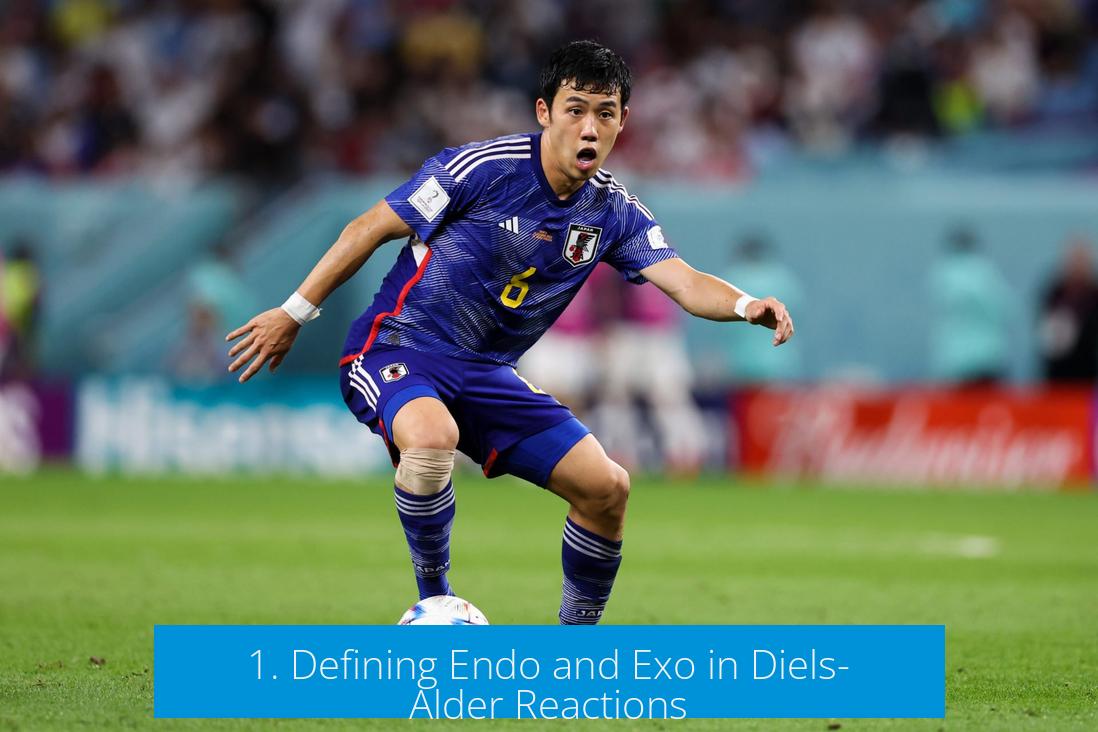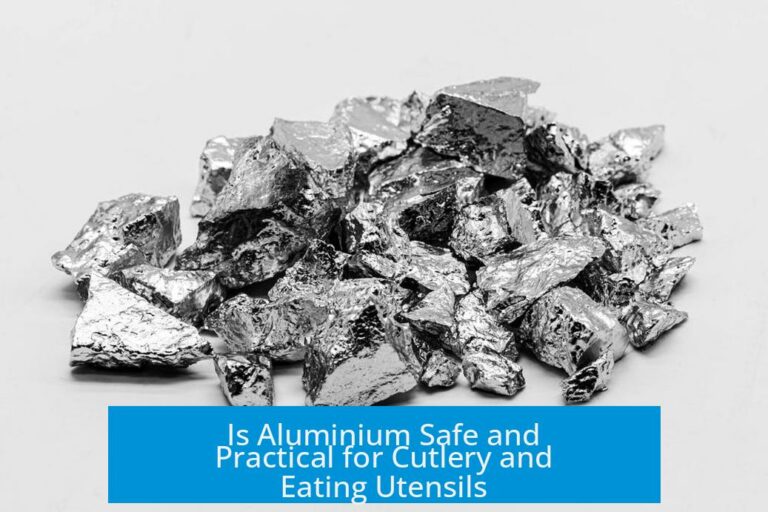Endo vs. Exo Product in Diels-Alder Reaction

The difference between endo and exo products in a Diels-Alder reaction lies in the spatial orientation of substituents on the newly formed six-membered ring, resulting in distinct diastereomers with different stabilities and formation kinetics.
This article explains the concepts behind endo and exo products, their identification, characteristics, and the factors influencing their formation. Examples from common dienes and dienophiles clarify their importance in synthetic organic chemistry.
1. Defining Endo and Exo in Diels-Alder Reactions

1.1 Spatial Arrangement and Cyclic Dienes

The terms endo and exo apply when the Diels-Alder reaction involves cyclic dienes. The product contains a bicyclic system formed from the diene and dienophile. The bridge in the bicyclic diene structure and the substituents on the dienophile can occupy different spatial positions relative to the ring system.
In the endo product, the substituents on the dienophile lie on the same side as the diene’s bridge but point inward toward the alkene (the “concave” face of the ring). Conversely, the exo product has the dienophile substituents pointing outward, on the convex face of the bicyclic ring, opposite the bridge.
1.2 Diastereomeric Relationship

Endo and exo products are stereoisomers. Since these are not mirror images, they are not enantiomers but diastereomers. This difference in spatial arrangement results in molecules with distinct physical and chemical properties.
1.3 Origin of Nomenclature
Diels and Alder originally identified the major product, where the dienophile points inward (endo), and named it accordingly. The minor product, with outward-pointing dienophile substituents, was termed exo, derived from “outside,” similar to “exoskeleton.”
1.4 How to Identify Endo and Exo Products
- Endo: The electron-withdrawing group (EWG) on the dienophile aligns on the same side of the new six-membered ring as the outside substituent of the diene.
- Exo: The EWG on the dienophile lies on the opposite side of the ring relative to the outside diene substituent.
2. Characteristics of the Endo Product
2.1 Relative Stereochemistry
In the endo product, the dienophile substituents and the bridge of the cyclic diene are positioned opposite across the ring. This arrangement ensures a spatial relationship where the substituents pointed “inward” are on the same face of the ring as the alkene internal to the bicyclic system.
2.2 Thermodynamic Stability
Despite apparent steric hindrance, the endo product tends to be more thermodynamically stable than the exo. Experimental evidence in the lab supports this; when left to equilibrate over time, the endo product usually predominates with a higher yield. This stability arises because the substituents do not sterically clash as much as anticipated.
2.3 The Endo Rule and Its Rationalization
The preference for the endo product can seem counterintuitive because of possible steric congestion. However, secondary orbital interactions between the π orbitals of the dienophile’s electron-withdrawing group and the π system of the diene stabilize the transition state leading to the endo product. This effect overrides the steric factors, making endo formation kinetically favored.
3. Characteristics of the Exo Product
3.1 Relative Stereochemistry
In the exo product, the dienophile substituents and the diene bridge are on the same side of the bicyclic ring, both “up” or both “down.” The dienophile substituents point outward, away from the alkene.
3.2 Kinetic Product and Stability
The exo product commonly forms faster in certain reactions but tends to be less stable thermodynamically. It represents the kinetic product. Over time, the exo isomer can sometimes convert to the more stable endo isomer under appropriate conditions.
4. Factors Affecting Endo vs. Exo Product Formation
4.1 Structure of the Diene and Dienophile
The presence of distinguishable substituents on the diene’s outside and inside positions is necessary to define endo and exo products. For example, with butadiene, where both inside and outside hydrogens are identical, endo and exo distinctions do not apply.
Similarly, the dienophile must contain a substituent recognized as an electron withdrawing group (EWG) to differentiate endo and exo. Simple dienophiles like ethylene or tetracyanoethylene lack such substituents, eliminating the opportunity for endo/exo stereoisomerism.
4.2 Electron-Withdrawing Groups on Dienophiles
The identity and position of EWGs on the dienophile play a crucial role. When the dienophile has symmetrical electron withdrawing groups on both ends, like dimethyl fumarate, no endo/exo distinction exists since both faces are equivalent.
5. Illustrative Examples
5.1 2,4-Hexadiene and Acrolein
In this system, the endo product positions the methyl groups and the aldehyde substituent on the same face of the ring, resulting in a particular diastereomer. The exo product, in contrast, places these groups on opposite faces.
5.2 Cyclopentadiene and Maleic Anhydride
This classic example features the endo product with the anhydride ring oriented toward the concave (inner) face of the bicyclic system. The exo product has the anhydride on the convex face, pointing outward.
5.3 Cyclohexadiene and Methacrylonitrile
The nitrile group defines the electron withdrawing substituent. Endo and exo are distinguished by whether the nitrile group and the bridge of the diene lie on the same or opposite sides of the ring.
5.4 Cyclopentadiene and Dimethyl Fumarate
This dienophile, having symmetrical electron withdrawing groups, shows no preference for endo or exo formation as both substituents are identical and positioned opposite each other.
6. Transition States and Their Role in Endo/Exo Selectivity
6.1 Equivalent Approaches Leading to No Endo/Exo Cases
For dienophiles like ethylene, lacking differentiated substituents, cyclopentadiene approaches can be “head-first” or “butt-first” without leading to different products. The transition states are identical, so endo/exo products do not arise.
6.2 Diastereomeric Transition States With Distinct Dienophiles
Maleic anhydride’s asymmetry offers distinct “head” and “tail” carbons for approach. As a result, the two approaches generate different transition states. These lead to the formation of two stereoisomeric products — the endo and the exo products.
7. Summary Table: Comparing Endo and Exo Products
| Feature | Endo Product | Exo Product |
|---|---|---|
| Spatial Arrangement | Dienophile substituents point inward (concave face), opposite to bridge | Dienophile substituents point outward (convex face), same side as bridge |
| Stereochemical Relationship | Diastereomer of exo | Diastereomer of endo |
| Stability | Thermodynamically favored, more stable over time | Less stable, kinetic product |
| Formation Rate | Slower but favored at equilibrium | Faster initial formation, kinetic control |
| Influencing Factors | Secondary orbital interactions with EWG stabilize transition state | Lacks stabilizing secondary interactions, less steric hindrance |
| Examples | Cyclopentadiene + Maleic anhydride (major product) | Cyclopentadiene + Maleic anhydride (minor product) |
Key Takeaways
- Endo and exo products are diastereomers resulting from different spatial orientations in Diels-Alder products involving cyclic dienes.
- Endo products have dienophile substituents pointing inward, toward the bicyclic ring’s concave face, opposite from the bridge, and are thermodynamically favored.
- Exo products have dienophile substituents pointing outward, on the same side as the bridge, and usually form faster but are less stable.
- The distinction depends on electron withdrawing substituents on the dienophile and the diene’s substituents; symmetrical groups negate endo/exo considerations.
- Secondary orbital interactions stabilize the endo transition state, overriding steric concerns that would otherwise favor the exo product.
- Many classic Diels-Alder systems such as cyclopentadiene + maleic anhydride illustrate these principles.
Endo vs. Exo Product in Diels-Alder: What’s the Deal?
If you’ve ever scratched your head wondering about the difference between endo and exo products in Diels-Alder reactions, you’re not alone. These terms pop up in organic chemistry classes and labs alike. The big question is: which one forms, and why? Well, here’s a quick take before we dive in deeper:
The endo product forms when the bridge from the cyclic diene and substituents from the dienophile are opposite to each other, and it’s generally more stable and thermodynamically favored. The exo product has these groups on the same side, forms faster (kinetic product), but is less stable.
Sounds simple enough, but there’s an entire story under the hood. Let’s unpack it.
What Do Endo and Exo Even Mean?
When you mix a cyclic diene with a dienophile, the magic of the Diels-Alder reaction happens: a six-membered ring forms. But not all products are siblings—some are diastereomers, called endo and exo.
- Endo product: The dienophile’s substituents point “inward”, toward the pi-system of the diene, the “concave” face. The bridge connecting carbons in the ring and the substituents from the dienophile are on opposite sides.
- Exo product: Both the bridge and the dienophile substituents are on the same side, pointing “outward” or on the “convex” face.
It dates back to Diels and Alder themselves. They saw that the major product had the electron-withdrawing group of the dienophile tucked underneath (endo), while the minor product had it sticking out (exo), kind of like “inside” vs “outside.”
How Do You Spot Endo or Exo?
Here’s a neat trick for your chem toolkit:
- Endo: The substituent on the diene’s outside connects to the same side as the electron-withdrawing group on the dienophile. They’re sharing the same “face” of the new ring.
- Exo: The diene’s outside substituent and the dienophile’s electron-withdrawing group sit on opposite sides of the ring.
When the diene is symmetrical (like simple butadiene), or the dienophile lacks a clear electron-withdrawing group (think ethylene), distinguishing endo versus exo is impossible—no diastereomeric battle here.
Why Does the Endo Product Usually Win?
Oddly, you’d expect the exo product to be the star because it has fewer steric clashes. Both bridge and substituents point outward or inward, so less bumping and jostling, right?
Yet experiments and even your trusty lab notebook remind you: the endo form usually dominates after some time. It’s the more thermodynamically stable species. How is this possible?
It turns out that secondary orbital interactions give the endo product an edge. The electron-withdrawing substituents interact with the pi-cloud of the diene, stabilizing the transition state leading to the endo product.
Think of it like two neighbors sharing a friendly fence rather than building walls. Sure, they’re close, but that closeness brings harmony (stabilization).
Endo vs. Exo: Kinetics and Thermodynamics in a Race
| Aspect | Endo | Exo |
|---|---|---|
| Position of Groups | Bridge and dienophile substituents on opposite sides | On the same side |
| Product Type | Thermodynamic (more stable) | Kinetic (forms faster) |
| Stability | Higher (less steric hindrance in product) | Lower (more steric hindrance) |
| Formation Rate | Slower, needs time to dominate | Faster, initial product |
So, in some sense, the exo product shoots out of the gate faster. But over time, equilibrium and molecular comfort favor endo. You can even observe this in labs if you let the reaction sit.
Examples That Bring Endo and Exo to Life
Concrete examples make concepts stick:
- Cyclopentadiene + Maleic Anhydride: The go-to textbook example. The endo product has the anhydride “nestled” on the concave face, while in exo, it’s “puffed out” on the convex side.
- 2,4-Hexadiene + Acrolein: Watch the methyl groups and aldehyde substituents. In endo, these groups face the same side of the ring; exo flips them opposite.
- Cyclohexadiene + Methacrylonitrile: The nitrile group guides endo/exo designation because it’s strongly electron-withdrawing, whereas the methyl group is less influential here.
But what about when the dienophile has symmetrical electron-withdrawing groups, like dimethyl fumarate? No clear head or tail means no endo/exo distinction—both faces are equivalent.
The Mechanistic Origin: What Happens in the Transition State?
Behind the curtain of the final product is a battle between two different transition states:
- With symmetrical dienophiles (like ethylene), all approaches are equivalent. No endo or exo—just product.
- With unsymmetrical dienophiles (maleic anhydride), “head-first” or “tail-first” approaches lead to different diastereomeric transition states.
This difference in transition states results in distinct activation energies and yields for endo and exo products. The transition state leading to endo enjoys stabilizing interactions, making it preferred despite potential steric hindrance.
Should You Always Aim for Endo?
Here’s the practical takeaway: if your reaction conditions allow, and the dienophile contains an electron-withdrawing group, the endo product will likely dominate given enough time. Putting it on ice and waiting may help—literally and figuratively.
But if you want speed or the dienophile lacks strong substituents, expect the exo kinetic product to emerge first.
So, depending on your goal—speed or stability—you can tweak the reaction conditions to favor your favorite stereoisomer.
Wrapping It Up: Endo and Exo in a Nutshell
Let’s cut to the chase:
Endo means the dienophile’s substituents tuck inside the ring away from the bridge, creating a product that’s thermodynamically more stable and favored over time. Exo means these substituents point outside, forming faster but less stable products. Your reaction’s structure and conditions determine which trumps.
If you want to master the Diels-Alder reaction, recognizing this dance between endo and exo products is key. It tells you not only what you get, but why. Next time you see these terms, you’re not just reading jargon—you’re unlocking the chemistry story beneath the surface.
So, which side do you root for: the fast and furious exo, or the endo, the cool, stable champion? Chemists everywhere have their bets placed. What about you?
What defines endo and exo products in the Diels-Alder reaction?
Endo products form when the dienophile’s substituents and the diene’s bridge are on opposite sides of the ring. Exo products have these groups on the same side. They differ in spatial orientation and are diastereomers.
Why is the endo product usually favored over the exo product?
The endo product is more thermodynamically stable and often formed in higher yield. Although it appears sterically hindered, its substituents do not interfere, making it more stable than the exo product.
How can you identify the endo product using substituent positions?
Endo has the electron-withdrawing group of the dienophile on the same side as the diene’s outside group in the new six-membered ring. For exo, these groups sit on opposite sides.
When do endo and exo distinctions not apply in Diels-Alder reactions?
If the diene’s inside and outside groups are identical or the dienophile lacks a distinct electron-withdrawing group, then endo and exo forms are indistinguishable or do not exist.
What role do transition states play in forming endo and exo products?
Diastereomeric transition states arise when the dienophile has distinct “head” and “tail” groups, leading to different endo and exo products. Equivalent approaches yield no endo/exo difference.





Leave a Comment